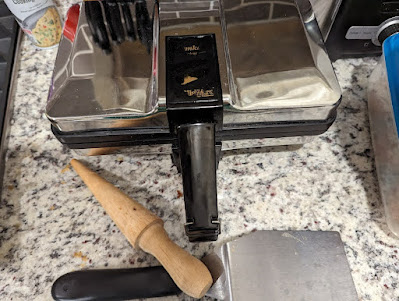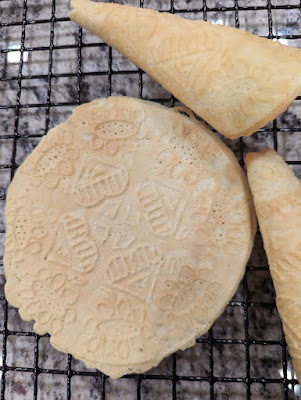Down a Fascinating Rabbit Hole: Random Discovery of Mormon Pioneers in the Family Tree
Mary “Polly” Randall Pulsipher: 1789-1912 (First Cousin 5x
Removed)
Harriet Pulsipher Pickett: 1811-1878 (Second Cousin 4x
Removed)
Elizabeth “Betsey” Randall Pulsipher : 1787-1857 (First
Cousin 5x Removed)
Sometimes I run across something that is very interesting
but yet very random. It can set me off -- down the rabbit hole so to speak,
hijacking my research plans for the day. That’s what happened when I started
looking at the Randall-Pulsipher family. I got distracted by this distant
offshoot of the family tree, but the entertainment value of my discoveries more
than made up for the loss of my time.
My random journey began a few weeks ago with a message from
FamilySearch informing me that I had a cousin who was a “pioneer”. I opened the
message and discovered it referred to my first cousin 5x removed, Elizabeth
“Betsey” Randall. She was the daughter of Deborah Rhoda Daniels, who was the
sister of my 4th Great Grandmother Polly Daniels, and the
granddaughter of my 5th Great-grandparents Samuel Daniels and
Elizabeth Noble. I was excited, imagining Elizabeth in a wagon out on the
prairie with Laura Ingalls Wilder or following the Oregon Trail. I quickly
realized my mistake: when FamilySearch refers to “pioneers”, they mean Mormons
who followed Brigham Young to Salt Lake City. I was surprised to find that I
had a Mormon in the family tree, and as I researched further, I discovered that
Elizabeth’s sister Mary “Polly” Randall was also a Mormon convert, and Polly’s
daughter was as well.
 |
| Polly Randall Pulsipher |
The Randall sisters grew up in Rockingham, Vermont with
their five siblings. They married the Pulsipher brothers, also from Rockingham.
Elizabeth married John Pulsipher March 2, 1809, and Polly married John’s
younger brother Zerah Pulsipher on November 6, 1810.
The two couples were not Mormons when they married. Joseph
Smith didn’t even found the Mormon faith until 1830. I was puzzled at how the
Pulsiphers discovered Mormonism. A family history written by an LDS researcher
offered one possible explanation, indicating that the Pulsiphers may have been distant
cousins of Joseph Smith’s. Adah Mackleprang Wood wrote: “John Pulsipher, (the father of Zerah) was born July 8, Married in
Rockingham, Elizabeth Dutton, who was born December 18, 1751, in Lunnenburg,
Massachusetts. She was the daughter of Thomas Dutton and his first wife, Mary
Hill. She was a descendant of the Thomas Dutton and his wife, Susanna, who
settled in Reading, Massachusetts, and were the fourth great-grand parents of
our “Beloved Prophet Joseph Smith”. (2)
However, I found Zerah Pulsipher’s memoir online, and it
provides a better explanation. Apparently Zerah was an itinerant Baptist minister
and farmer living in Onondaga, New York when he heard about Joseph Smith’s
“golden tablet”. He wrote he heard of “an
ancient record or Golden Bible in Manchester near Palmyra which remark struck
me like a shock of electricity at the same time thought it might be something
that would give light to my mind upon principles that I had been thinking of
for years and many times I had remarked that if the pure church with its gifts
and graces was not on the earth, if so I had not found it.”
He went to hear a
Mormon missionary, but was not completely convinced until he had a vision in
his barn where a “light came over my head
which caused me to look up. I thought I saw the angels with the Book of Mormon
in their hands in the attitude of showing it to me and saying “this is the
great revelation of the last days in which all things spoken of by the prophets
must be fulfilled.” The vision was so open and plain that I began to rejoice
exceedingly so that I walked the length of my barn crying “Glory Hal-la-lu-ya
to the God and the Lamb forever.”
But when my mind
became calm I called the church together, (Note: he was their minister) and
informed them of what I had seen. I told them of my determination to join the
Church of Latter Day Saints, which I did and a large body of my church went
with me. I was ordained to the office of an elder and went to preaching with
considerable success at home and abroad. I had the privilege of baptizing
Wilford Woodruff on the 31st of December, 1833, at Richland, New York.” (4)
 |
| Zerah Pulsipher |
By the time of his conversion, Zerah was a widower who had
remarried. Polly had given birth to their only child, Harriet Pulsipher, on
September 11, 1811. Polly died a little over a year later on November 26, 1812,
possibly in childbirth with a second child.
Zerah mentioned inviting his brother John and sister-in-law
Elizabeth to live with him and farm in his autobiography, noting first that “John
also married, but had no children.” He later wrote: “In the year 1814 I hired a farm at Bellows falls on the Connecticut
River and being alone gave my brother John the privilege to work it with me.”
I suspect that Elizabeth provided care for young Harriet as part of this
arrangement, which ended at some point before the 1820 census. Zerah next moved
to Pennsylvania where he married Mary Brown, and then on to Onondaga.
 |
| Article in 1963 LDS paper about Zerah |
John Pulsipher converted to Mormonism as well, probably
brought into the faith by his brother. He and Elizabeth followed the Mormons to
their new settlement in Kirtland, Ohio. They were still living in Rockingham at
the time of the 1830 census, so moved later in that decade. Zerah had arrived
in Kirtland in 1835, so John and Elizabeth either accompanied Zerah and his family
or followed him a bit later. John is
mentioned in the 1838 Kirtland Elders Quorum Record as being proposed for
ordination. (3)
John and Elizabeth never had children, and he died in September
3, 1840 at the age of 58. I have found no death record for him. I suspect he
died in Kirtland, but John and Elizabeth may have chosen to follow Zerah
Pulsipher and most of the Mormon faithful to their next settlement in Daviess
County, Missouri around 1839, so he may have died there. The Mormons were
living under harsh conditions, with little food and frequent illness, which
makes John’s death all too understandable.
Zerah’s autobiography doesn’t mention his brother’s death,
but may contain one final reference to Elizabeth. He reports that he sent his
daughter Mariah and his “sister” to care for desperately ill Mormons in Nauvoo.
Since his natural sisters had married in Vermont and were living with their
husbands and families at that point, I suspect he was referring to his widowed
sister-in-law, who he probably had taken into his household. He also had his
mother living with him.
Zerah moved to Utah in the first big migration from Nauvoo.
He was president of the First Seventy, a high position in the church, so was
considered an early leader in the church. He entered into a plural marriage,
having three wives and numerous children.
Elizabeth travelled west with a Mormon wagon train in 1853.
She is listed among the pioneers in the Daniel A. Miller/John W. Cooley
Company, who left Six Mile Grove in Iowa (a now non-existent place in Harrison
County along the Iowa border with Nebraska) on June 8 and arrived in Salt Lake
City on September 9, 1853. She was 66 years old—an amazing age to decide to
travel over 950 miles in a jouncing wooden wagon for three months. She does not
seem to have travelled with any Pulsipher family members, so I am not sure who
took responsibility for her during the arduous journey. (5)
 |
| Record of Elizabeth's blessing by Pres. Wofford |
She lived in Ward 15 in Salt Lake City until her death on
June 3, 1857 at the age of 70. Janet Hassard reported on FamilySearch that “Elizabeth
Randall Pulsipher was sealed as a sign of love and respect to President Wilford
Woodruff before President Woodruff's teaching that children should be sealed to
their own parents.” Zerah Pulsipher wrote that he had baptized President
Woodruff, so there was probably a strong relationship between the two families.
As for young Harriet Pulsipher, Polly and Zerah’s daughter,
she married Hiram Pickett of Onondaga, New York. They followed the Mormon
faithful to Ohio, settling in Geauga County, and then moved to Nauvoo,
Illinois. However, following the attack at Nauvoo that killed Joseph Smith, the
couple did not follow the Mormons to Utah. Instead, they moved to Green County
Wisconsin, settling in the town of Monroe where they raised their six or seven
children.
 |
| Harriet Pulsipher Pickett |
According to a county history, Hiram “was there at the time the trouble occurred with the Mormons at Nauvoo,
previous to their removal to Salt Lake. In 1843 he removed from Illinois to
Green Co., Wis. The following year he settle at Wiota, where he resided till
the spring of 1867. He then moved to Monroe, where he died Dec. 12, 1872.”(1)
 |
| Hiram Pickett headstone |
It does not appear that the Picketts continued with the
Mormon faith—perhaps the Nauvoo violence led them to rethink. Harriet died
October 2, 1878 at the age of 67. At least five of her children survived to
adulthood and had families of their own. Sons Nelson and Daniel and their
families appear on the 1860 census for Wiota Wisconsin, just before the entry
for Harriet and Hiram.
I was fascinated by what I discovered in my research about the
early days of Mormonism. Digging through the Kirtland Elders Quorum Records was
a delight—people getting censured for flirting or expressing doubts about the
latest revelation from Joseph Smith. Zerah Pulipher’s autobiography was even
more enticing—his “visions” were quite amazing, and his life experiences were
quite harrowing. While I fell down a very twisty rabbit hole, this random bit
of research was very entertaining.
Sources:
1. The History of Green County Wisconsin. Hiram
Pickett 1809-1872. Springfield, Ill.; Union Publishing Company 1884. Page 755.
2.
THE EARLY
PULSIPHER FAMILY HISTORY. Research
and Arranging by Adah Mackleprang Wood. https://www.ancestry.com/family-tree/person/tree/46986934/person/322508961954/hints
3.
Kirtland
Elders Quorum Record, 1836-1841. July 15 and July 22, 1838 Records. https://josephsmithfoundation.org/kirtland-elders-quorum-record-1836-1841/
4.
AUTOBIOGRAPHY OF ZERAH PULSIPHER (C. 1803-1862),
History of Zera Pulsipher as Written by Himself. https://doctrineandcovenantscentral.org/history/zerah-pulsipher/
5.
Miller/Cooley Wagon Train member list: https://history.churchofjesuschrist.org/chd/list?filterOrganizationUri=%2Forganization%2Fpioneer-company%2Fdaniel-a-millerjohn-w-cooley-company-1853&subtype=pioneer-activity
6.
Photo of Zerah Pulsipher from FamilySearch,
posted by mikellnelson1. https://www.familysearch.org/photos/artifacts/124681436?p=47699639&returnLabel=Zera%20Pulsipher%20(K2HH-5XK)&returnUrl=https%3A%2F%2Fwww.familysearch.org%2Ftree%2Fperson%2Fmemories%2FK2HH-5XK



























.jpg)
















